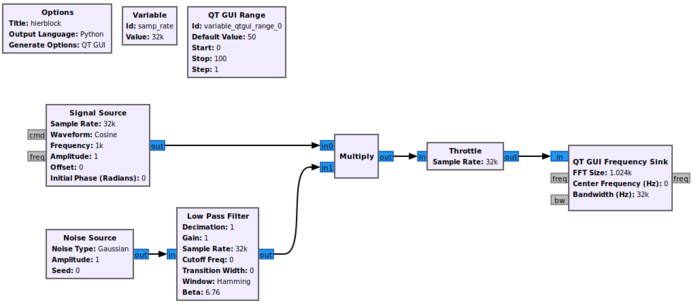Hier Blocks and Parameters: Difference between revisions
Jump to navigation
Jump to search
Mattcarrick (talk | contribs) No edit summary |
Mattcarrick (talk | contribs) |
||
| Line 10: | Line 10: | ||
# ''Signal Source'' | # ''Signal Source'' | ||
# ''Multiply'' | # ''Multiply'' | ||
# ''Noise Source'' | |||
# ''Low Pass Filter'' | |||
# ''Throttle'' | # ''Throttle'' | ||
# ''QT GUI Frequency Sink'' | # ''QT GUI Frequency Sink'' | ||
Revision as of 17:07, 12 January 2022
This tutorial describes how to create a hierarchical block, or Hier block, in GRC. The previous tutorial, Creating Your First Block, demonstrates how to create your first GNU Radio block using the Embedded Python Block.
Creating a Flowgraph
A hier block is used to encapsulate and simplify multiple GNU Radio blocks into a single block. The example hier block will be a frequency shifter block which multiplies a Signal Source against an input signal.
The first step is creating the flowgraph. Drag and drop the following blocks into the workspace:
- Signal Source
- Multiply
- Noise Source
- Low Pass Filter
- Throttle
- QT GUI Frequency Sink
- QT GUI Range
Connect the blocks:
